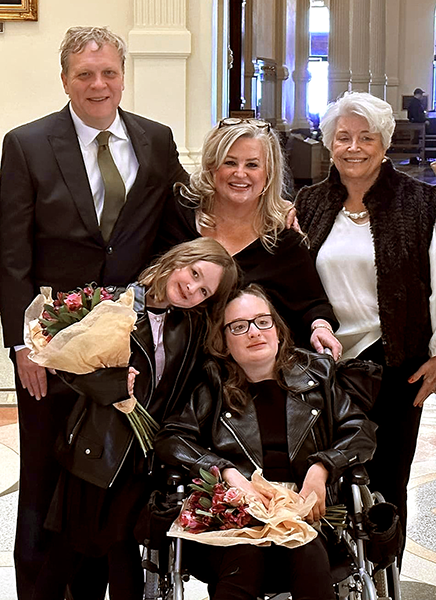A Family’s Journey From Diagnosis to Advocacy
Chris and Pam Andrews, on behalf of the Firefly Fund, have announced a $5 million gift to Dell Med to go toward the launch of the first rare disease center in the Austin area. The center will serve the Austin community and beyond in providing rare disease research and therapies. The gift is in honor of their two daughters, Belle and Abby.

Christopher, Belle, Pam and Abby Andrews
For close to three years, Pam Andrews spent each night scouring the internet for what could be causing these symptoms in her daughter Belle: Tripping and falling. Low platelets. Enlarged spleen. Search.
“I would wake my husband up and say, ‘What about this disease? What about Friedreich’s Ataxia? What about Gaucher disease?’ All these random possibilities,” Pam said.
The Andrewses’ search for answers began when Belle was 3 1/2 years old, after multiple falls and two broken noses led the family to a pediatric orthopedist. That pursuit took the family to eight specialists across the country over nearly three years, all while Belle’s condition continued to decline.
“That began what the rare disease community would call our ‘diagnostic odyssey,’” Pam said.
It takes patients with rare diseases an average of six to seven years to get an accurate diagnosis, during which time these illnesses often worsen. For Belle, that diagnosis was Niemann Pick Type C (NPC), a rare genetic disease estimated to affect 1 in 250,000 people. Because NPC is genetic, Pam and Chris decided to test their 18-month-old daughter, Abby, as well. Though she was asymptomatic, Abby tested positive for the gene that causes NPC, and both daughters began treatment immediately. For children like Abby who have not yet begun to show symptoms, treatment is not only more effective but can also slow or even halt progression of the illness.
The long, taxing journey to diagnosis made Pam and her husband, Chris, painfully aware of our health care system’s lack of clinical care and research in pediatric genomics and rare diseases. In 2017, the couple founded the Firefly Fund, which offers resources, support and reassurance to families experiencing a diagnosis of NPC or other rare neurodegenerative genetic diseases.
Z. Leah Harris, M.D., chair of Dell Medical School’s Department of Pediatrics, has been part of Belle and Abby’s care team since August 2020. She immediately noticed the family’s passion and depth of knowledge of rare genetic diseases.
“They are amazing ambassadors for children with rare diseases, as both a family and individuals,” Harris said. “When you’re a parent of a child with a rare disease, especially when it’s not yet diagnosed, finding a community and having hope that help is out there becomes really important.”
That network of knowledge, support and solutions is the vision behind the Firefly Fund’s $5 million gift to Dell Medical School to support a new Center for Rare Diseases. The center will focus on translational research and novel therapeutics that support advances in diagnostics and awareness for patients dealing with rare diseases, including children and their families.
“Every person I’ve spoken to in the rare disease community has had that experience where they truly did not know what to do next,” Chris Andrews said. “Why can’t the place where diagnosis occurs also connect you to experts in treating that disease, clinical trials and a community of people who understand the despair of this awful diagnostic journey?”
“This Center for Rare Diseases will provide hope to children and parents for years to come,” said Claudia Lucchinetti, dean of Dell Medical School and The University of Texas at Austin’s senior vice president for medical affairs. “By investing in cutting-edge research, we aim to support patients and their families as we find new ways to treat and, one day, hope to cure many of these diseases.”
Despite what the term might imply, Steve Ekker, Ph.D., says that treating rare diseases actually affects the entire health care system. Ekker is a professor of pediatrics and molecular biosciences at Dell Medical School, as well as the school’s associate dean of innovation and entrepreneurship. He also serves as The University of Texas at Austin’s associate vice dean of research translation, all roles that reflect his experience in gene editing and commercializing scientific discoveries.
How Rare Diseases Affect Everyone
“In the aggregate, rare diseases are not all that rare,” Ekker said. “One in 17 Americans is living with a condition we classify as rare. So what we think of as isolated illnesses are actually a challenge to our entire health care system. Because we often don’t effectively diagnose these patients or incorporate them into our existing health care system, these conditions have an outsized impact on our health care system and costs.”
Not only does researching rare diseases help alleviate those costs, but the findings often translate to a range of other illnesses, rare, genetic, or not.
“There are core biological issues that span and impact many different diseases,” Ekker said. “By treating the absolute rarest diseases, we learn more about the central processes that impact everyone.”
Harris takes that further.
“What a rare disease provides is a clearer picture of the actual, physiologic function of the affected cell,” she said. “So by studying them, you not only learn how cells are supposed to work, you get to see how they adjust when they’re not functioning as intended. What a rare disease ends up doing is educating us on fundamental cellular development.”
Through genetic editing, that research is already happening at The University of Texas at Austin, and it will grow with the Firefly Fund’s gift.
“Once you can identify a disease at the DNA level, you can insert it into different biologic tools. That means a study of one case can become a study of 100,” Harris said. “Not only does that help us understand how a disease may progress, but it also gives us a platform to test potential therapeutics, whether that’s repurposing existing drugs or developing new ones. How exciting to be part of UT Austin, with vibrant colleges of Pharmacy and Natural Sciences, with amazing molecular biology partners, all thinking about drug discovery in a way that actually impacts families.”

Front: Abby and Belle Andrews. Back: Chris and Pam Andrews and Beryl Crowley.
This kind of research is what the Andrewses are hoping to inspire with the Center for Rare Diseases.
“We believe that the pathway to curing diseases like Alzheimer’s and Parkinson’s is through treatments of rare disease,” Chris said. “Nobody knows the cause of Alzheimer’s. But in rare disease, we know the cause. If you are able to find treatments for conditions that mimic more prevalent ones, those treatments will transfer over into those larger diseases.”
Like many genetic diseases, the progression of Niemann Pick C can be stopped but not reversed. Thanks to her early diagnosis and treatment, Abby remains completely without symptoms, while Belle will never walk or speak again.
“This gift is in their honor,” Pam said. “It’s a legacy for them to give something back to the community that has given so much to us. So that the children who come behind them who are diagnosed with rare diseases don’t have to suffer through their own diagnostic odysseys.”